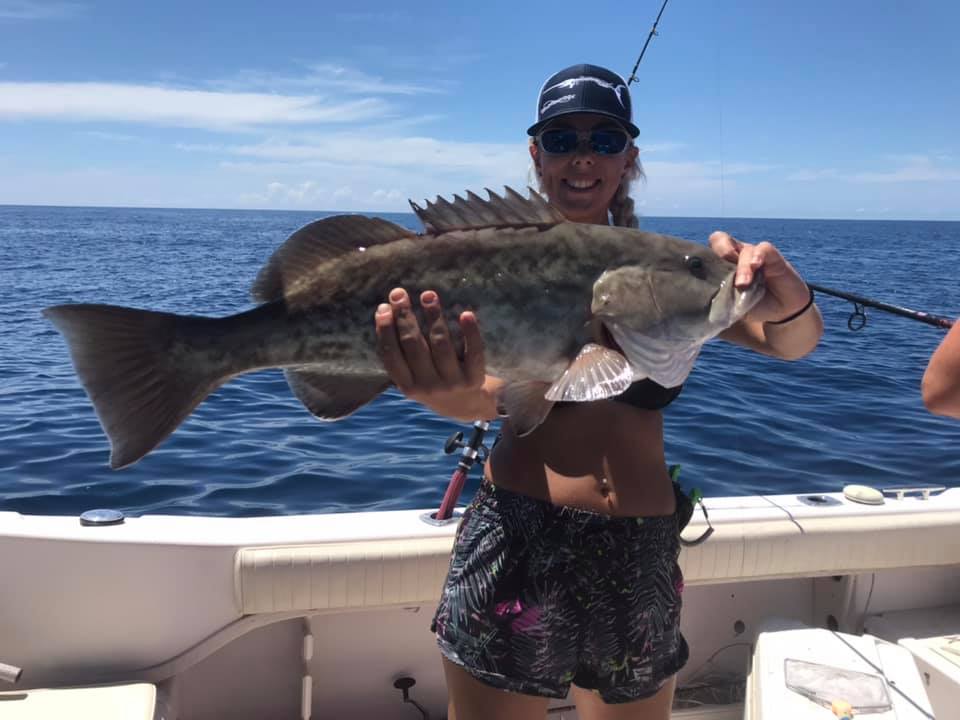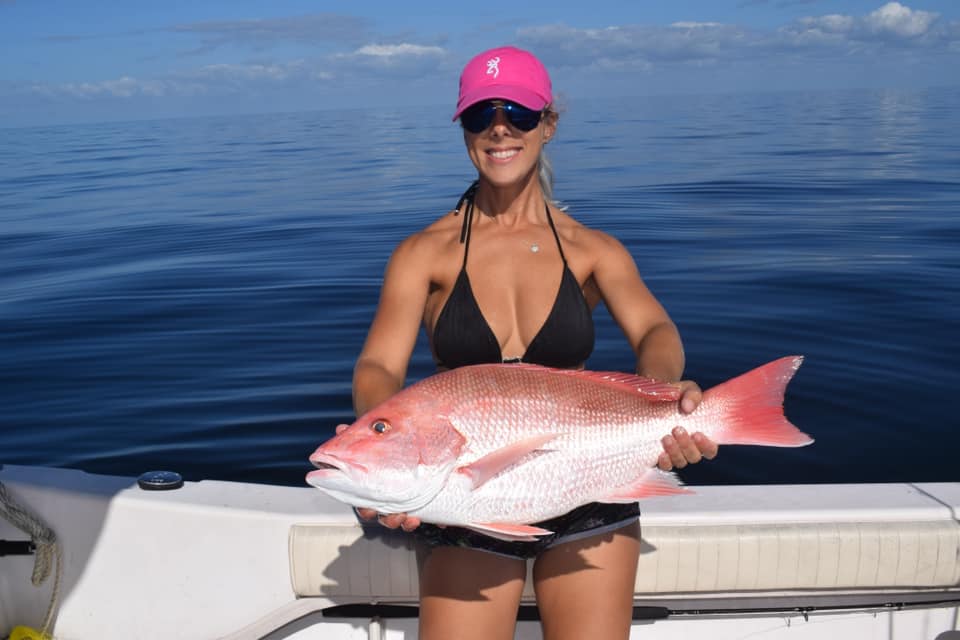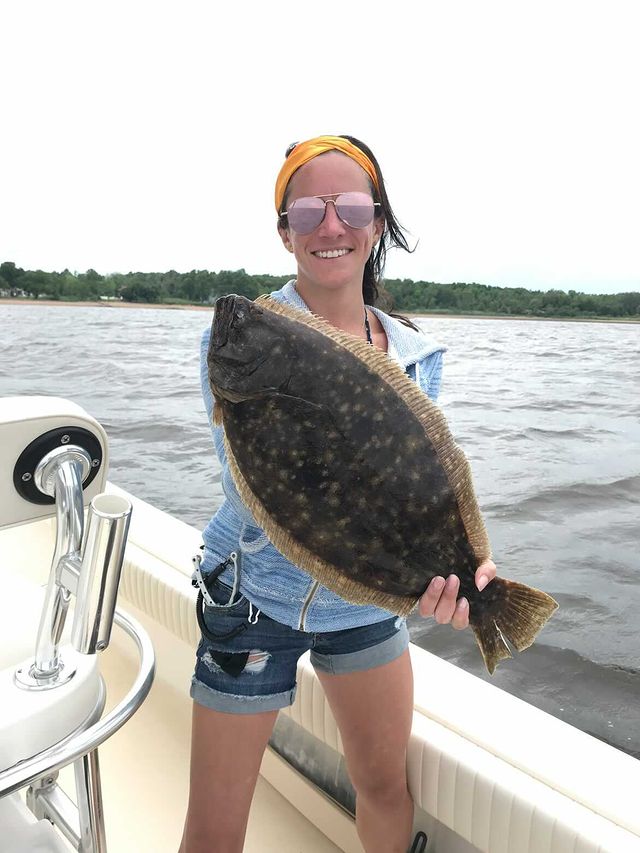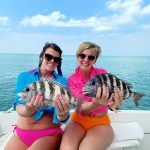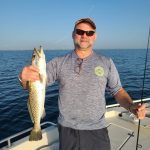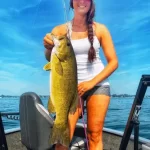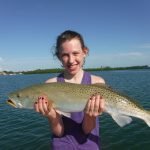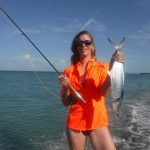Bottom Fishing -Tips, Tackle, and Techniques
This article will share some great bottom fishing tips and techniques. It will cover the tackle, rigs, baits, locations, and species that can be taking using this fishing method. Capt Jim is a fishing charter captain in Florida, and shares his experience in this article.
Bottom fishing is a simple, yet extremely effective fishing technique. In its basic form, it is simply lowering a weighted hook to the bottom with some type of live or natural bait attached. Many fish species being near structure close to or on the bottom. Anglers can use light tackle bottom fishing to pursue fish of just about any size. This includes both freshwater fishing and saltwater fishing. Much of the information in this article will apply to anglers fishing for just about any species all over the world.
Best bottom fishing tackle
Many anglers conjure up the notion of very heavy rods, large reels, and big fish when the term “bottom fishing” is mentioned. However, the reality is that the vast majority of fish landed by anglers bottom fishing do so using fairly light tackle. This can range anywhere from catching bluegill and other panfish and freshwater to saltwater species such as flounder and snapper.
Top 11 bottom fishing tips are;
- Use just enough weight to hit and hold the bottom
- Anchor up-currrent from the spot being fished
- Match the hook size to the bait size, not the size of the fish
- Circle hooks will reduce fish mortality
- Egg sinkers are used to drift a bait
- Pyramid sinkers are used to hold the bait in one spot
- Reeling quickly when a bite occurs is better than setting the hook
- In deep water, try to keep the line vertical
- Most bottom fishing is done near structure
- Strips of cut bait work well in current
- Chunks of cut bait work in the surf
There are some advantages to using light tackle when bottom fishing. First off, matching lighter tackle two smaller fish will greatly enhance the fish fighting capabilities of the species being sought. Even a small fish will put up a nice battle by anglers using ultralight tackle. Light tackle is also less cumbersome and physically demanding to use. These lighter rods are less expensive. Finally, and most importantly, this presentation often results in more bites!
Best fishing line for bottom fishing
Anglers have a choice when it comes to fishing line; monofilament line or braided line. Both have advantages and disadvantages and there really is no wrong choice. It is really a matter of angler preference. Braided line is more expensive. However, it is very sensitive and lasts a long time. So bites are more easily detected with braided line. Knots are a bit more difficult to tie.
Monofilament line is less expensive and knots are much easier to tie. However, monofilament line does stretch and is less sensitive. Monofilament line will also twist and break down over time. It is probably the best choice for beginning anglers.
Bottom fishing rods and reels
For the majority of anglers bottom fishing for smaller fish, spinning outfits are the best choice. They are relatively inexpensive, easy to use, and very versatile. This makes spinning tackle the overwhelming choice for novice anglers and for children. The best spinning outfit to use will vary greatly depending on the species being sought and the environment that it is being used.
Check out the best inshore saltwater fishing tackle
Conventional outfits certainly have their place for anglers bottom fishing as well. These outfits work very well and both freshwater and saltwater applications. Conventional tackle is preferred by many saltwater anglers fishing inshore waters for flounder, sea bass, tautog, grouper, snapper, triggerfish, and more. Freshwater fishermen may use them when bottom bouncing for walleye or fishing for larger fish around deep water structure.
Anglers can click this link to shop Amazon for spinning combos
An all-round spinning combo
Anglers seeking one versatile all round spinning outfit will do well with a 6 1/2 foot to 7 foot medium light spinning rod matched with a 2500 to 3000 series reel. 10 pound monofilament or braided line works well with this outfit. Anglers fishing in saltwater will want to get a rod and reel with corrosion resistant components.
Anglers can shop at Amazon for a Daiwa Black Gold reel and St Croix Triumph 7′ MF rod spinning combo in this link.
“Fishing Lido Key is a participant in the Amazon Associates Program, an affiliate advertising program designed to provide a means for sites to earn advertising fees by advertising and linking to Amazon. As an Amazon Associate I earn from qualifying purchases.”
This outfit will work well in both fresh and saltwater applications. It will be fine for light tackle bottom fishing for inshore saltwater species such as snapper, sheepshead, seabass, and other species. It will also work well for just about any fresh water bottom fishing for anything other than very large fish.
Conventional rod and reel for bottom fishing
As mentioned earlier, there is a place for conventional outfits when bottom fishing, particularly in the inshore saltwater venues and for catfish in rivers. Swift currents and heavy structure such as bridges, jetties, and submerged timber will often require anglers to use fairly heavy weights. In this application, conventional tackle is often the best choice as it will handle the heavier weights and larger fish better.
A 7′ to 7 ½’ rod with a medium action and a matching reel with a levelwind is an excellent combination. The “levelwind” device goes back and forth across the reel, spooling the line evenly. 20 lb monofilament or braided line is a good match. These reels are not meant to be cast, but instead bottom fishing as well as trolling.
Anglers can click this link to shop Amazon for Penn conventional outfits
“Fishing Lido Key is a participant in the Amazon Services LLC Associates Program, an affiliate advertising program designed to provide a means for sites to earn advertising fees by advertising and linking to Amazon”
Best bottom fishing rigs
There are many different rigs that anglers use when bottom fishing. However, there are several that are the most popular and effective. These are the sliding sinker, ( also known as the Carolina rig), spreader rig (also known as a chicken rig or high/low rig), 3 way rig, and knocker rig.
Sliding sinker bottom fishing rig
The sliding sinker rig, or Carolina rig, and it’s many variations, is a very effective rig for bottom fishing. Catfish anglers in particular get very creative. The running line passes through the sinker. A swivel stops the sinker and the leader is attached to it, followed by the hook. This rig allows for the fish to pick up the bait and move off with it without feeling the resistance of the weight.
Spreader rig for bottom fishing
The spreader rig, or high/low rig, is another effective rig used by anglers bottom fishing. It is most effective in a vertical presentation, but is also used by anglers surf fishing as well. It consists of a sinker at the bottom, with multiple hook being tied off at intervals. This allows for multiple baits to be presented at several distances above the bottom.
3 way rig
The 3 way rig is a versatile rig that can be used in most bottom fishing applications. However, it really shines when drift fishing. A 3 way swivel is attached to the main line. A dropper line connects the weight to the second ring on the s way swivel. Finally, a leader is attached to the third ring followed by the hook.
The leader and dropper lengths can be adjusted to match the conditions and species being sought after. Leader lengths can be a foot or 6 feet or more. Anglers will use floats to lift the bait up off the bottom. Often times, a lighter line is used on the sinker dropper, saving the rig should the sinker snag.
Knocker rig
The knocker rig is a variation of the sliding sinker rig. The sinker rides right up against the eye of the hook. Note the weight in the picture above. This keeps the bait right on the bottom. It also makes getting snagged rigs unhooked from the structure. Finally, rigging is fast and easy.
Bottom fishing hooks
Hooks come in a myriad of sizes, shapes, colors, and finishes. Basically, there are two types of hooks; J hooks and circle hooks. Circle hooks have become very popular of late as they tend to hook the fish in the mouth, reducing fish mortality after being released. “J” hooks are still very popular and used by the majority of anglers who bottom fish.
Hook size is generally determined by the size of the bait being used as well as the fish being pursued. Anglers presenting delicate baits for smaller fish often opt for a fine wire hook. Conversely, anglers chasing larger fish near heavy structure will need a stout or hook.
Hook sizes
Hook sizes can be a little confusing. Starting at #1 and going up, the larger the number, the smaller the hook. In other words, a #2 hook is larger than a #10 hook. However, once a hook gets larger than a #1, they switch to and “ought” system. It is represented like this, 1/0 would be a “one ought” hook. From there, the larger the number, the larger the hook. A #1/0 hook is smaller than a #5/0 hook.
Generally speaking, freshwater anglers targeting panfish and other small species will do well with a #6 to #10 fine wire live bait hook. These often have little barbs on the shank to help hold the bait on the hook. These are aptly named “bait holder” hooks and are a very good all-around choice. Anglers targeting larger species such as bass, catfish, and walleye can bump the size up with #2, #1, and #1/0 being the best all round sizes. #1/0 is a very good all round saltwater hook size to start with, but obviously can be adjusted to the application.
Circle hooks
Circle hooks are sized a bit differently which complicates matters a little bit. The hook is sized by the distance between the point and the shank. Due to the shape of circle hooks, this results in anglers often using a circle hook that is two or three sizes larger than that what they would use in a “J” hook.
Circle hooks have a unique design. They have a cam like action when in a fishes mouth which causes it to turn and catch the lip on the way out. This results in the majority of fish being hooked in the outer lip. Obviously, this aids and releasing the fish in better condition. Anglers using circle hooks cannot set the hook! Instead, they need to let the line get tight then simply lift the rod tip and reel.
Anglers light tackle bottom fishing can use several different techniques. Many anglers successfully bottom fish from shore as well as docks. Anglers can anchor and fish vertically in deep water or cast toward structure in shallow water. Finally, anglers can choose to drift while presenting baits on the bottom.
Bottom fishing sinkers
Fishing sinkers come in quite a variety of shapes and weights. There are many specialty sinkers for anglers chasing catfish and other species. However, fishing sinkers basically break down into three types; egg sinkers, bank sinkers, and pyramid sinkers. While the three types are interchangeable, there are situations that makes one preferable over the other.
The general rule of thumb when choosing a weight is to use the least amount that will reach and hold bottom. In saltwater fishing, title flow is constantly changing. This requires anglers to adjust the weight of the sinker to match the conditions. This is true in freshwater as well, especially when fishing rivers.
Egg sinkers
Egg sinkers are probably the most commonly used sinker when fishing. They are generally round or egg shaped with a whole running through the metal. The running line slides through this hole and then a swivel is attached. This will not only stops the weight from sliding down to the hook, it gives anglers something to attach the leader to.
The primary advantage to using egg sinkers is that a fish can pick up the bait and move off with it without feeling any resistance from the weight. The sinker will remain at the bottom while the line slides through the hole in the center. Egg sinkers work best when bottom fishing from a stationary position over structure. They also work well when drifting, as long as the bottom is relatively free. Egg sinkers will lodge themselves in rocky structure if allowed to drift.
Bank sinkers
Bank sinkers, as the name implies, are often used by anglers casting baits out from the shore. They are shaped a bit like a bowling pin with a hole at the top for the line to be attached. Bank sinkers work well with spreader rigs as they tend to hold bottom in both sandy and rocky bottoms. Bank sinkers also work pretty well when drifting over the submerge structure as the shape tends to bounce over the rocks instead of getting lodged in them. Anglers use bank sinkers with most 3 way rigs.
Pyramid sinkers
Pyramid sinkers are most often used by anglers surf fishing. Freshwater river anglers use them as well. They are designed to hold the bottom in the sand. Pyramid sinkers will snag quickly when fished over rocky bottom. Surf anglers use a clever device called a fish finder. This is a plastic tube with a clip on it. The running line passes through the tube, much like a sliding sinker rig. A clip on the tube allows for anglers to easily and quickly change the weight of the sinker to match the conditions.
Bottom fishing techniques
Anglers bottom fishing can use several different techniques. Many anglers successfully bottom fish from shore as well as docks. Anglers can anchor and fish vertically in deep water or cast toward structure in shallow water. Finally, anglers can choose to drift while presenting baits on the bottom.
Bottom fishing from shore
Probably the oldest form of bottom fishing was anglers casting a baited line out from shore. This technique still produces plenty of fish. Anglers chasing catfish, walleye, panfish, and other freshwater species do well using both live and cut bait. Saltwater anglers cast cut bait from shore when surf fishing as well as fishing from docks and piers.
The biggest obstacle to anglers bottom fishing from shore as limited access to fishing spots. Basically, shore bound anglers are limited to public areas where they can access bodies of water. Also, they can only fish spots that are within casting distance of shore. Still, anglers can be very successful bottom fishing from shore.
The spreader rig is often times the best choice for anglers bottom fishing from shore. This rig allows them to present multiple baits a little bit off the bottom. This generally snags less often. Bank sinkers are most often used in this application.
Bottom fishing from an anchored boat
Many anglers do their light tackle bottom fishing from an anchored boat. This is especially true when fish relate to smaller pieces of structure such as rock piles, bridges, piers, docks, and ledges. The most effective technique is to anchor up current of the area to be fished. The bait can then be presented back to the fish in a natural manner.
Both the spreader rig and sliding sinker rig will work well in this application. The choice often depends on the species being sought after. Fish that are right on the bottom such as flounder will often respond best to the sliding sinker rig, which keeps the bait closer to the bottom. Conversely, fish that school a foot or two off the bottom such as perch and snapper will like the spreader rig better.
Drifting baits on the bottom
Drifting can be an extremely effective technique for bottom fishing. It allows anglers to cover a lot of water in search of feeding fish. The one downside to drifting is that anglers will inevitably hang up more often, especially when fishing rocky bottoms.
The three-way rig is most often used when drift fishing. Anglers will often times use lighter test line on the branch going from the swivel to the weight. That way if the weight snags the lighter line will break, saving the rest of the rig. This will save time when rereading and getting a bait back into the water.
Best bottom fishing baits
The list of baits that anglers have used successfully to catch fish is a long one! Just about any fish, insects, or crustaceans that can be found in or near the water can be and has been used for bait. However, anglers are not even limited to that. Items found in the grocery store such as chicken livers and even soap have been used successfully by anglers. Finally, there are many commercially prepared baits that can be bought at tackle shops. These are convenient, easy to store, and effective.
Often times, the best approach is to visit a local bait and tackle shop. These folks stay up on what is biting and the best baits and spots. Local conditions and baits vary greatly depending on the region. Online resources can be excellent as well.
Freshwater baits
Freshwater anglers use live baits including worms and nightcrawlers, minnows, crayfish, helgramites, leeches, grasshoppers, and crickets. Anglers using live baits generally hook them in such a way that they will remain lively while still staying firmly attached to the hook. This will vary depending on the bait being used.
Cut baits and commercially prepared baits work well and freshwater, too. Just about any oily fish can be cut up and used for bait, with suckers, shad, and herring being the top baits. While catfish are often the primary species being pursued, cut bait will catch just about any fish that swims.
Commercially prepared baits have become popular of late. These can be paste type of baits that are used for catfish and even trout. Fish egg baits are also very popular for stream trout fishing. Dehydrated grass shrimp and other insects are a favorite among pan fisherman. In most cases, these baits can be kept sealed in a tackle box for long periods of time. This makes them very convenient.
Saltwater baits
Saltwater anglers certainly have their choice when it comes to bottom fishing baits as well. Top live baits include live bait fish, shrimp, and crabs. Saltwater anglers use fresh and frozen cut baits much more often than freshwater anglers do. Just about any locally caught fish can be cut up and used for bait, as long as regulations allow it.
In conclusion, this article on bottom fishing will help anglers everywhere catch more fish!
